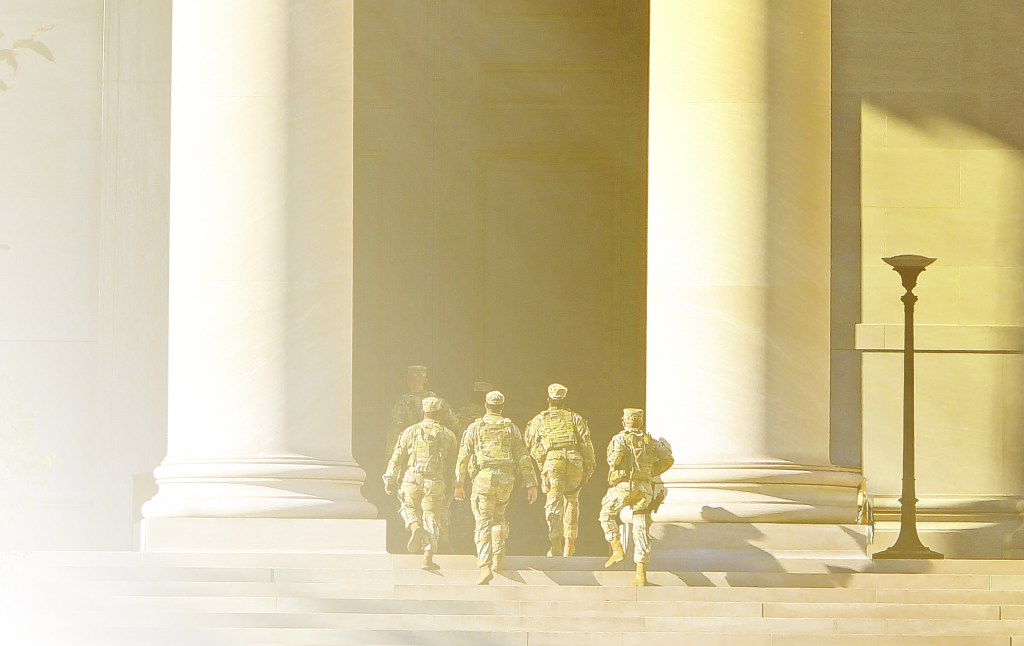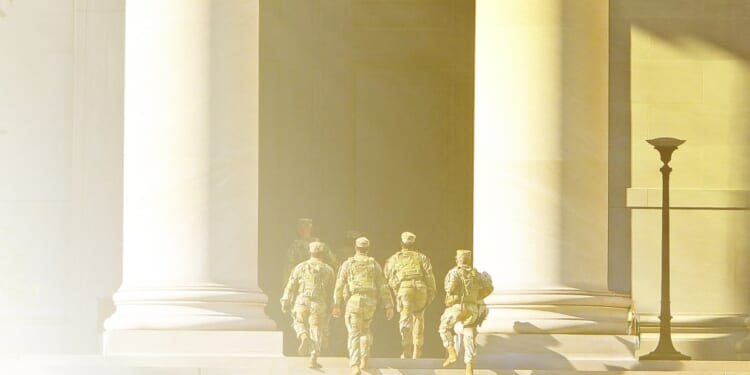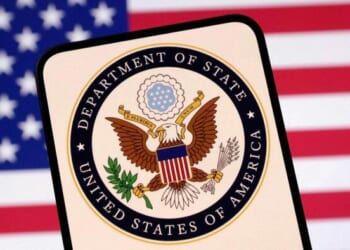
President Donald Trump claims many major American cities are criminal hellscapes so unsafe that only by deploying uniformed and armed National Guard personnel—or even U.S. Marines—can we solve the problem. Is his reading accurate?
I spent 11 years in the National Guard and Army Reserve and was part of a group of Missouri Guard personnel called up to assist with post-tornado security and anti-looting operations in my hometown of Springfield, Missouri, in April 1983. As such, I have some thoughts about how Guardsmen should (and should not) be used during or after actual emergencies.
Let’s begin with the president’s premise and then examine his proposed solution. Simply stated, there was and is no “crime emergency” in any major American city targeted by the Trump administration for National Guard deployments.
Indeed, in March 2025, Los Angeles officials announced major reductions in violent crime throughout 2024. During her September 2025 congressional testimony, D.C. Mayor Muriel Bowser noted major crime reductions in multiple categories compared to 2023: burglaries (down 34 percent), motor vehicle theft (down 37 percent), homicide (down 44 percent), robberies (down 60 percent), carjackings (down 71 percent), and overall violent crime (down 53 percent). A month earlier, Chicago Mayor Brandon Johnson announced a one-third reduction in homicides in the first half of 2025 compared to 2024.
Those reductions were achieved before Trump’s decision to activate National Guard units for deployment to those cities. Accordingly, Trump’s stated purpose for the call-ups has never had a logical basis.
“Simply stated, there was and is no ‘crime emergency’ in any major American city targeted by the Trump administration for National Guard deployments.”
Patrick G. Eddington
“Many cities have abdicated their enforcement responsibilities and/or actively undermined federal law enforcement priorities. This has created a vacuum into which federal authorities can (and should) step.”
Rafael A. Mangual
There are proven ways to reduce crime, even violent crime, and it has been and is being accomplished without resorting to the deployment of Guardsmen or active-duty military personnel. Independent researchers, such as Jerry Ratcliffe of the University of Pennsylvania, have noted that the targeted deployment of uniformed police to crime “hot spots” is a technique that has successfully reduced certain types of crimes. The Department of Justice defines the tactic as follows:
Hot spots policing strategies focus on small geographic areas or places, usually in urban settings, where crime is concentrated. Through hot spots policing strategies, law enforcement agencies can focus limited resources in areas where crime is most likely to occur. This practice is rated Effective for reducing overall crime and rated Promising for reducing violent, property, public order, and drug and alcohol offenses.
The National Institute of Justice (NIJ) website features summaries of the results of a 2019 meta-analysis showing not only a reduction in overall crime when these policing techniques are used, but reductions in violent crime, property crime, and public order offenses as well. Moreover, field research conducted by criminologists Brandon Tregle and Scott M. Mourtgos found that in Salt Lake City, hot spots policing was effective when the strategy was data-driven and had officer buy-in.
With the exception of the Capitol Hill area, none of the National Guard deployments in Washington, D.C., were to the hot spot crime areas known to the Metropolitan Police Department—the Columbia Heights, Shaw, Petworth, and U Street neighborhoods, for example.
But I have repeatedly encountered Guard troops at the Metro Center station and along streets in the area bounded by I Street and Massachusetts Ave., NW. Indeed, when I spoke with several of the troops I met, they said they were in the nation’s capital for a “presence mission,” a vague concept disconnected from hot spots or any other kind of policing.
Moreover, most of the troops I encountered were not from military police units, but line infantry (i.e., combat) units. According to the personnel I spoke with, their only pre-deployment law enforcement training was a PowerPoint presentation on the Constitution and Bill of Rights. If they encountered criminal conduct, suspected or real, their orders were to reach out to the police officers nearby and notify their chain of command.
Bottom line: These troops were called up to do a job they were never trained for and sent almost exclusively to areas of D.C. that were not, and are not, crime hubs.
Trump’s decision to deploy military assets for policing duty has been an expensive boondoggle. Last month, Taxpayers for Common Sense noted that Pentagon estimates of the cost of just the National Guard and U.S. Marine deployment to Los Angeles for 60 days would reach at least $134 million. Factor in the deployments to D.C., Portland, Chicago, and Memphis, and the strategy looks on track to cost American taxpayers several hundred million dollars more.
If the true goal is crime reduction, allocating those funds to build properly staffed and well-trained police forces would be the rational policy choice—not mobilizing thousands of soldiers with no law enforcement background or training.
Indeed, for decades the Department of Justice has administered two congressionally created grant programs to assist states and localities with combating crime. The first, the Community Oriented Policing Services (COPS), provides states and localities with federal funds to help hire more police officers. The other, the Edward Byrne Memorial Justice Assistance Grant (JAG) program, supports both general and targeted crime control efforts, and the funds can also be used to purchase equipment for officers. These programs enjoy generally strong bipartisan support in Congress and among police departments nationwide. Reorienting them to only fund crime-fighting programs of proven, validated effectiveness would be vastly preferable to mobilizing and deploying Guard units that are unqualified to perform police functions.
The federal intervention into local crime fighting is also legally dubious. Trump’s use of the National Guard in multiple states, often over the explicit objections of several governors, has of course spawned multiple costly lawsuits against the deployments.
The arguments that Govs. Gavin Newsom of California and J.B. Pritzker of Illinois have made, that the deployments are unnecessary and pretextual, have real merit. Indeed, in early September U.S. District Judge Charles Breyer of the Northern District of California issued a ruling finding that Trump’s California National Guard call-ups and deployment violated the 1878 Posse Comitatus Act, the statute that prohibits the use of military personnel for domestic law enforcement operations.
Breyer’s 52-page opinion is well-argued, fact-rich, and damning in tone. Yet even if these various lawsuits are taken up by the Supreme Court—and they likely will be—the existing court majority will likely side with Trump regarding his authority to engage in such call-ups.
The justices have been particularly deferential in giving Trump latitude for his often legally dubious immigration enforcement operations in cases involving the Alien Enemies Act, Temporary Protected Status determinations, third-country deportations, and immigration sweeps in Los Angeles, as well as in matters involving national security. That is as dangerous as it is unwise.
Even if Trump were correct that violent crime is enough to warrant emergency measures, deploying National Guard units is the wrong solution. Moreover, taking these troops away from their core mission—backing up the active-duty soldiers in wartime—undermines military readiness and thus our national security.
That’s not simply my opinion; it’s the view of retired Vice Chief of the National Guard Maj. Gen. Randy Manner. When Trump announced his D.C. Guard federalization and related deployments in late August, Manner told NPR that Trump’s actions were “unprecedented,” adding “[t]his is absolutely a law enforcement operation in the very best of cases.” His reasoning was clear: “It is not a military operation. It does not require National Guardsmen or active-duty military.” Manner also pointed out that Trump’s call-ups “negatively impact military readiness, because [they] pull people, soldiers and airmen, out of their units and reduce their ability for those units to prepare for war, for deployment.”
There are some who might argue that prior National Guard and even active-duty military unit call-ups in the wake of the Supreme Court’s Brown v. Board of Education decision were law enforcement operations. Those episodes did not involve vague “crime control” operations by military personnel, but were rather federalization actions designed to strip state governors in Alabama and Mississippi of their ability to defy the Supreme Court’s school desegregation decision.
Trump’s deployment of the National Guard to “solve” crime in cities controlled primarily by his political opponents is a public spectacle and lawfare-based power grab, not a public safety solution. As noted above, the publicly available data from police departments in Chicago, Los Angeles, and Washington, D.C., showed crime already on a downward trajectory prior to Trump’s deployment of National Guard personnel to those cities.
Meanwhile, targeted, data-driven, community-partnered programs cut homicides, reduce gun violence, and improve clearance rates at a fraction of the cost of Trump’s call-ups.
If the goal is truly to create safer streets in the long term, the answer lies not in marching soldiers onto sidewalks, but in hiring the right officers, equipping them with intelligence, and pairing them with trusted community partners. That is the kind of evidence-based, humane approach our cities deserve—and the one that will stand up to public scrutiny.

















